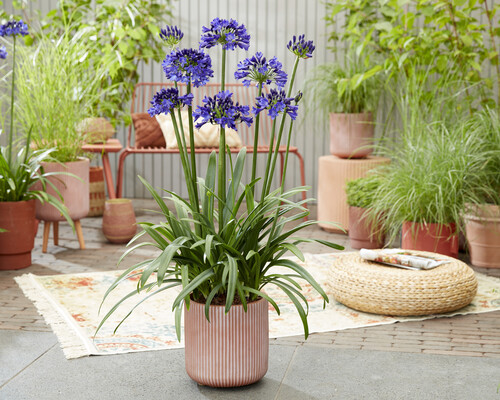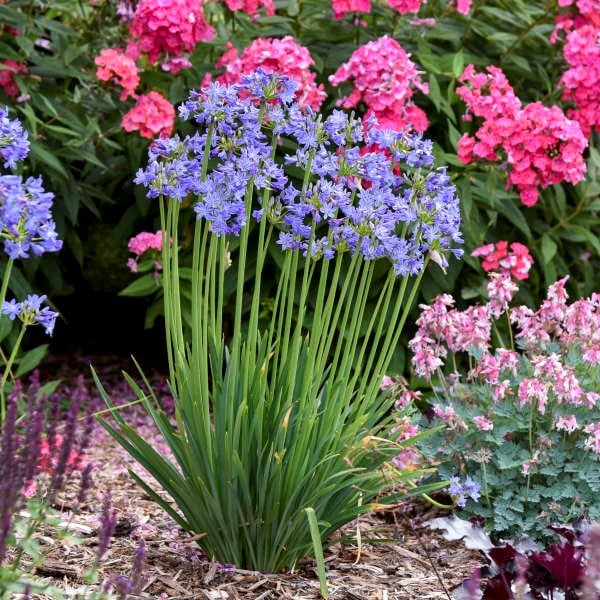Agapanthus Care Tips for Lush and Vibrant Flowers
Agapanthus Care Tips for Lush and Vibrant Flowers
Blog Article
Understanding the Art of Agapanthus Care: Crucial Actions for Healthy Growth and Vivid Blooms
In the realm of cultivation, the cultivation of agapanthus stands as a gratifying undertaking for those that look for to nurture these classy blooming plants. From selecting the right selection to understanding trimming strategies, the trip in the direction of cultivating flourishing agapanthus plants is diverse and holds the crucial to unlocking the complete capacity of these herb gems.

Choosing the Right Agapanthus Variety

When picking the ideal Agapanthus selection for your yard, take into consideration elements such as environment viability, flower color, and growth behavior. Furthermore, consider the climate in your region to make sure the Agapanthus variety you pick can thrive in your details conditions. Recognizing the growth habit of various Agapanthus ranges is essential for correct placement within your yard.
Perfect Planting Problems
Considering the ideal ecological demands is vital for successful Agapanthus farming. Agapanthus grows in well-draining soil with a somewhat acidic to neutral pH degree. When planting, choose an area that gets full sunlight to partial shade. In hotter climates, offering some afternoon color can prevent scorching of the leaves. Agapanthus plants are delicate to cold temperature levels and should be secured from frost throughout wintertime months.
To make certain healthy development and vibrant flowers, plant Agapanthus light bulbs at a deepness of regarding 2-4 inches and area them 8-12 inches apart. Adding natural issue, such as garden compost, to the soil can boost drainage and fertility, promoting robust root growth. Mulching around the base of the plants assists preserve moisture and reduces weed development. Routine watering is important, specifically throughout the expanding period, to maintain the soil constantly wet yet not saturated.
Watering and Feeding Tips
Keeping appropriate wetness levels and providing essential nutrients are key elements in the care regimen for Agapanthus plants. When it comes to sprinkling Agapanthus, it is essential to strike a balance. These plants prefer continually damp soil yet are at risk to root rot if overwatered.
Feeding Agapanthus is necessary for advertising healthy and balanced growth and prolific blooms. Use a well balanced plant food, such as a 10-10-10 formula, in the early springtime as new growth arises. By complying with these watering and feeding suggestions, you can ensure your Agapanthus plants prosper and produce lively, durable blossoms.
Pruning Techniques for Agapanthus
Trimming Agapanthus plants at the appropriate times and with correct strategies is essential for keeping their health and advertising optimum growth and blooming. The optimal time to trim Agapanthus is in late winter months or very early spring prior to new growth emerges. Begin by removing any dead or yellowing fallen leaves near the base of the official source plant. Cut them as short as feasible without harming the emerging shoots.
Deadheading invested flowers can likewise reroute the plant's power into producing more blooms rather than establishing seeds. If you want to gather seeds for breeding, leave some flowers to mature and dry on the plant.
Bear in mind to make use of tidy, sharp devices to make accurate cuts and reduce the risk of presenting conditions. Agapanthus. Normal trimming will assist maintain your Agapanthus looking healthy and balanced and neat while making certain an abundant screen of beautiful blooms
Handling Usual Bugs and Conditions
After guaranteeing correct pruning techniques for Agapanthus, it is vital to resolve common parasites and illness that can influence click reference the wellness and vitality of these plants. Agapanthus plants are normally durable yet can still come down with specific problems. One typical pest that influences Agapanthus is the Agapanthus gall midget. This tiny, orange fly lays its eggs in the vegetation, causing altered growth and blossom buds that stop working to open up. To combat this insect, trim and ruin any damaged plant components and take into consideration making use of insecticidal soap.
One more common issue is fungal leaf spot, which offers as dark lesions on the fallen leaves. To avoid fungal diseases, guarantee great air flow around the plants, prevent above watering, and remove any type of infected fallen leaves without delay. Additionally, Agapanthus plants can experience from origin rot if they are planted in inadequately draining dirt. To avoid this, plant Agapanthus in well-draining dirt and stay clear of overwatering. By being attentive and taking punctual activity against conditions and bugs, you can help your Agapanthus plants prosper and generate vibrant blooms.

Final Thought
In final thought, grasping the art of agapanthus treatment includes selecting the best variety, providing optimal planting conditions, appropriate watering and feeding, appropriate pruning methods, and dealing with common parasites and conditions. By adhering to these crucial actions, you can ensure healthy growth and lively blossoms for your agapanthus plants. Remember to frequently keep track of and keep your plants to advertise their total wellness and longevity.
To ensure healthy and balanced growth and dynamic blooms, plant Agapanthus light bulbs at a depth of about 2-4 inches and area them 8-12 inches apart. By adhering to these watering and feeding ideas, you can ensure your Agapanthus plants grow and create vibrant, durable flowers.
One common insect that influences Agapanthus is the Agapanthus gall midget. Additionally, Agapanthus plants can endure from root rot if they are grown in improperly click for more draining dirt. By following these essential actions, you can make sure healthy development and dynamic blossoms for your agapanthus plants.
Report this page